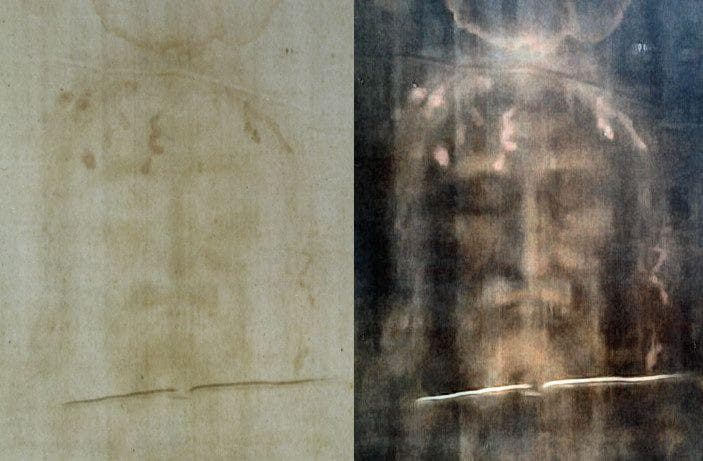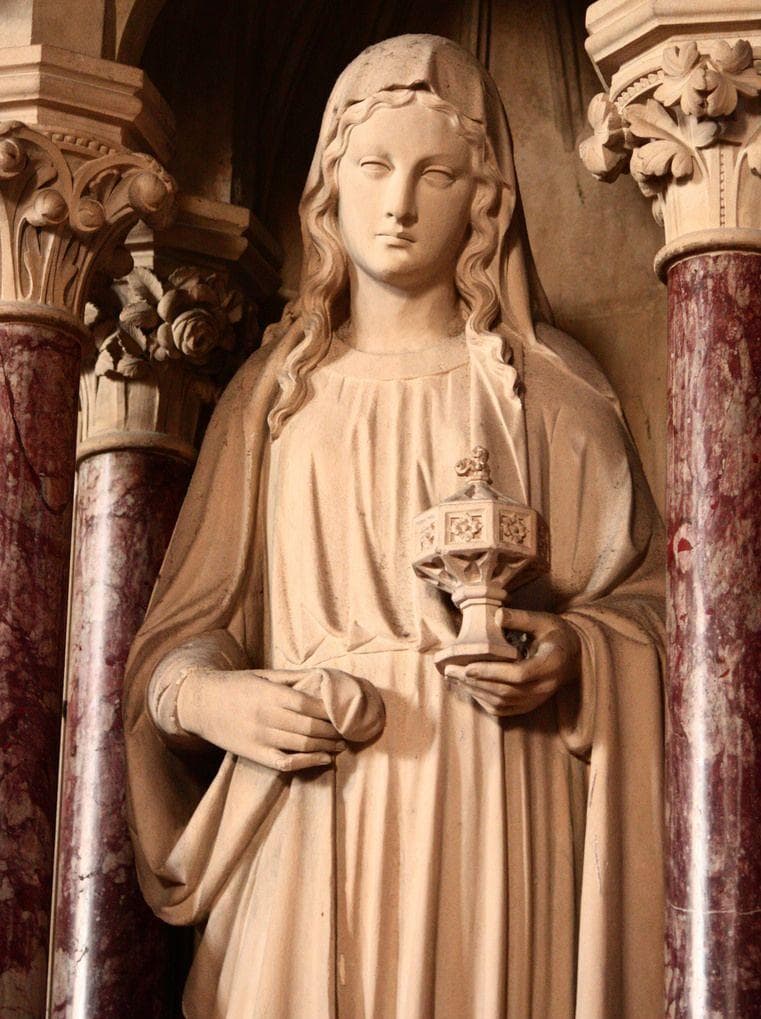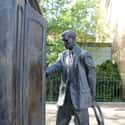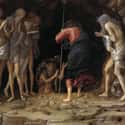-
(#1) The Harrowing Took Place Between Jesus' Passing And Resurrection
Before we delve into the Harrowing, let's first define the timeline. The Gospels of Matthew, Mark, Luke, and John are the Bible's official accounts of the life and passing of Jesus Christ. And while they differ from each other on many of the details (which has lead to endless debate over the past two millennia), all four Gospels agree on a basic set of facts: Jesus was hung on the cross on Good Friday and expired at 3 pm. Joseph of Arimathea arranged for Jesus to be interred in a tomb that same day. On Sunday, one or more of Jesus' female followers visited the tomb and discovered that Jesus had been resurrected.
This leaves a chronological gap between Jesus' passing and his resurrection. What did he do in between? According to contemporary first-century Judaic theology, all humans have a soul that goes to the afterlife after they expire, which then awaits the final judgment. Since he was both the son of God and mortal, Jesus was no exception. But unlike other mortals, Jesus' journey to the afterlife had a more specific purpose.
-
(#2) This Isn't The Hell Modern Readers Are Familiar With
Today, when we think of "hell," we think of a fiery underworld kingdom ruled by Satan, where the souls of sinners go after they perish to suffer eternal torment. Jesus does describe a place like this in the Gospel of Matthew. He warns the disciples against suffering the judgment of "Gehenna," a lake of fire where non-believers suffer God's judgment, which was based on a real-life trash dump near Jerusalem.
However, the location Jesus visits in the Harrowing is not Gehenna. It's also more in line with first-century beliefs about the afterlife. Throughout the Old Testament and into the New Testament, it was believed that everyone, human or animal, went to the same place after they passed, regardless of their behavior in life. In Hebrew, this place was called "Sheol"; in Greek, it was called "Hades." After the mortal flesh expired, the soul went to Sheol to await its final judgment. This is where Jesus went after he passed.
The modern version of hell owes more to later writers like St. Augustine and Dante than the Bible itself.
-
(#3) The Harrowing Details Jesus Descending Into Hell To Save The Souls Of Those Who Perished Before Him
While branches of Christianity differ on the specifics, the main draw for followers of Jesus is that accepting his teachings and repenting for their sins guarantees salvation. Moreover, salvation is only available to people who accept him.
According to this theology, the arrival of Jesus on Earth was a game-changer for people alive at the time, and for everyone who has lived after. But it also creates a problem: What about the people who lived before Jesus' birth, souls who never had the chance to learn his teachings?
The Harrowing is a theological solution to this problem. Rather than waiting for eternity, the souls of everyone who predated Jesus were saved when he visited hell before his resurrection.
The use of the word "harrowing" to describe this event might be confusing to modern readers. Here, the word "harrowing" does not mean "distressing" like we would use it today. Instead, it's rooted in an Old English word that means "to break the ground in preparation for planting." In other words, Jesus' harrowing was a means of preparing the souls of the afterlife for their eternal salvation.
-
(#4) The Four Gospels Don't Mention The Harrowing
When it comes to the gap between Jesus' passing and resurrection, Matthew, Mark, Luke, and John don't have much to say about where Jesus went. Instead, they mainly focus on what his followers do until he reappears. None of the four Gospels specifically mention the Harrowing, and this is one reason why it's been a controversial subject among Christian scholars for the past two millennia.
There is only one moment in the Gospels that deals with the deceased in relation to Jesus' passing, and it appears in Matthew 27:50-51:
But Jesus cried out again with a loud voice and gave up his spirit. Suddenly, the curtain of the sanctuary was torn in two from top to bottom, the earth quaked, and the rocks were split. The tombs were also opened and many [cadavers] of the saints who had fallen asleep were raised. And they came out of the tombs after his resurrection, entered the holy city, and appeared to many.
Unlike in the story of the Harrowing, Jesus does not venture into hell to save the deceased. Instead, they leave on their own. Furthermore, in Matthew's version, Jesus doesn't explicitly save their souls.
-
(#5) The Harrowing Is Barely Mentioned In The Canonical Bible At All
Though the Gospels - considered the definitive chronicle of Jesus' life and passing - do not mention the Harrowing, it may be alluded to in other books of the New Testament.
Written by Paul in 62 AD, Ephesians 4:9 says, "When [Jesus] ascended on high he led a host of captives, and he gave gifts to men." Here, the "captives" refer to the souls that Jesus rescued from hell.
In Acts 2:31, Jesus foresees his demise, descent into hell, and his ultimate fate: "Seeing what was to come, he spoke of the resurrection of the Messiah, that he was not abandoned to the [afterlife], nor did his body see decay."
Even though it isn't detailed at length in the Bible, belief in the Harrowing still became one of the tenets of Christianity. It appears in the Apostles' Creed, a statement of belief that forms the cornerstone of many Christian faiths: "[Jesus] suffered under Pontius Pilate; was crucified, dead and buried. He descended into hell. The third day he rose again..." The inclusion of the Harrowing in the Apostles' Creed is credited to just one person, a fourth-century bishop named Rufinus, who mentions it in his commentary on the text.
It also appears in the Catechism of the Catholic Church, a longer document that lays out the tenets of Catholicism in detail. The book describes the Harrowing as the "last phase" of Jesus' messianic mission, and says Jesus "opened heaven's gates for the just who had gone before him."
-
(#6) The Most Detailed Accounts Of The Harrowing Are Apocryphal
So, if the Harrowing doesn't appear in the official record of Jesus' life and passing, and it's only briefly mentioned in other parts of the Bible that were written well after Jesus' time, how did it become a central belief of Christianity?
Originally, there were numerous other scriptures that claimed to teach the Gospel of Jesus, yet these were not included in the official Bible. These books are called "apocrypha," and even though they aren't official canon in Christianity, various sects still followed them at different times. They also influenced what did get included in the Bible.
The most detailed accounts of the Harrowing come from two of these apocryphal Gospels. The first, the Gospel of Peter, explicitly says that Jesus brought his message to the souls of the afterlife: "For unto this end was the gospel preached even to the [deceased], that they might be judged indeed according to men in the flesh, but live according to God in the spirit."
An even longer depiction of the Harrowing appears in the Gospel of Nicodemus. In this version, Hades and Satan are portrayed as two separate figures. Before Jesus arrives, they debate as to whether Jesus really has the power to save the souls of the deceased. Satan is confident that Jesus will have no power in hell, but Hades isn't so sure. When Jesus appears in hell, Hades and Satan are quickly overpowered and Jesus completes his task.
-
(#7) Jesus Saves Several Old Testament Figures In The Harrowing
Some apocryphal Gospels go so far as to specify exactly who Jesus rescues when he goes to hell - namely, the heroes of Old Testament stories who carried out God's mission. In the Gospel of Bartholomew, the resurrected Jesus tells Bartholomew that he rescued the very first humans, Adam and Eve: "Then I went down into Hades that I might bring up Adam and all those who were with him, according to the supplication of Michael the archangel."
The Gospel of Peter specifies that Jesus rescued Noah and his family:
[Jesus] was [ended] in the flesh, but made alive in the spirit, in which also he went and made a proclamation to the spirits... who in former times did not obey, when God waited patiently in the days of Noah, during the building of the ark, in which a few, that is, eight persons, were saved through water... For this is the reason the gospel was proclaimed even to the [deceased], so that, though they had been judged in the flesh as everyone is judged, they might live in the spirit as God does.
-
(#8) Certain Denominations Disavow The Tale Precisely Because The Bible Makes Little Mention Of It
While Catholic theology explicitly recognizes the Harrowing, plenty of branches of Christianity do not. The 13th-century Catholic theologian Thomas Aquinas describes Jesus' descent into hell in detail in his Summa Theologiae. However, while Aquinas does write that Jesus went to hell to teach his gospel, he argues that it didn't ultimately save anyone. According to Aquinas, a person's soul becomes fixed at their passing and repenting is no longer possible in the afterlife. This text laid the groundwork for future rejections of the Harrowing.
In the 16th century, Protestant reformer and theologian John Calvin argued that Jesus never actually visited hell. Instead, the story is an allegory that symbolizes his suffering on the cross. Additionally, Calvin believed a person's redemption or damnation was fixed at birth, so it would have been impossible to save anyone from hell regardless of whether or not they had the chance to hear Jesus' message.
Also in the 16th century, Protestant reformer Martin Luther posited that the Harrowing was allegorical instead of literal. Luther was skeptical of the Catholic vision of hell, and even took things one step further by denying that places like limbo and purgatory even exist. He described the latter two realms as "figments of some stupid and bungling sophist."
Today, most mainstream Protestant religions do believe that Jesus really did go to hell after his passing - but whether they believe it literally or metaphorically depends on the denomination.
-
(#9) Numerous Other Religions Embrace The Story
The followers of Eastern Orthodox Christianity not only believe in the Harrowing, but also consider it a much more central feature of their Easter worship than it is for the Western branches of Christianity. "The icon that represents Easter for us is not the empty cross or tomb," says theology professor Peter Bouteneff. "It’s Christ’s descent into Hades."
The typical depiction of the Harrowing in Eastern Orthodox iconography shows Jesus standing triumphantly atop the toppled gates of Hades, guiding Adam and Eve by the hand out of hell, and followed by other figures from the Old Testament like Abraham and David.
The Church of Jesus Christ of Latter Day Saints also believes in the Harrowing of Hell, but not as a one-time event that followed Jesus' passing. Instead, Mormons believe that redeeming the souls of the unbaptized deceased is an ongoing process that continues to this day.
-
(#10) The Harrowing Was The Subject Of Numerous Medieval Plays
One way the Christian church spread its message was through the use of "liturgical plays," or dramas depicting stories from the Bible or the lives of the saints. These weren't usually part of a typical church service, but instead were performed for the general public.
The Harrowing of Hell was frequently depicted in these plays. The earliest discovered liturgical play, The Harrowing of Hell, comes from a ninth-century Anglo-Saxon text called The Book of Cerne, and it's believed to be the earliest dramatic work ever produced in England.
Liturgical dramas were most popular in the 12th and 13th centuries. In plays about the Harrowing of Hell, Jesus is often depicted not as a peaceful teacher, but as a confident warrior-king who triumphs over evil and rescues Adam and Eve.
-
(#11) Author C.S. Lewis Was A Passionate Believer In The Harrowing
Today, C.S. Lewis is known as the author of classic works like The Chronicles of Narnia and The Screwtape Letters. He was also a devout Christian and amateur theologian, which shouldn't surprise anyone familiar with the themes in his books.
When Lewis was active in the 1960s, a major school of contemporary thought rejected the ideas of heaven and hell as purely fictional. To Lewis, heaven and hell were real places, and essential to his version of Christianity. Hell is necessary as a consequence for non-belief, Lewis believed. Or, in other words, "If a game is played, it must be possible to lose it."
The concept of the Harrowing of Hell was central to Lewis's theology. To Lewis, the Harrowing of Hell episode is the entire basis for the possibility of eternal life. In a letter to friend Mrs. Sutherland, Lewis wrote:
The New Testament always speaks of Christ not as one who taught, or demonstrated, the possibility of a glorious after life but as one who first created the possibility - the Pioneer, the First Fruits, the Man who forced the door. Now, with Jesus’ completed work, he has made a way, prepared a home, made many mansions for us.
-
(#12) Even Today, Scholars Debate The Harrowing’s Meaning And Whether It Should Be Accepted As Canon
Even today, the status of the Harrowing is by no means settled. Modern theologians still debate what it means, and even whether it should be believed at all.
The controversial Swiss theologian and priest Hans Urs von Balthasar rejects the traditional Catholic interpretation of the Harrowing in his 1970 book Mysterium Paschale. Whereas traditional theology views Jesus' ordeal on the cross as his atonement for mankind's sins (and his descent into hell as a triumphant announcement to the souls who passed before him), von Balthasar argues that the Harrowing is itself the final act of atonement.
In von Balthasar's version, Jesus' descent was a final act of damnation that had to happen before he could be resurrected. It is not so much a triumph as the low point of his suffering.
In 1991, theologian and president of the Evangelical Theological Society Wayne Grudem argued in his textbook Systematic Theology that, due to the lack of Biblical evidence, the Harrowing should be deleted from the Apostles' Creed entirely. "The single argument in its favor seems to be that it has been around so long," he writes. "But an old mistake is still a mistake."
New Random Displays Display All By Ranking
About This Tool
The Bible records that Jesus ascended to heaven on the fortieth day after his resurrection. Any interpreter admits that this is the most difficult passage in the New Testament. The interpretation of hell in Christian doctrine is terrible. In different biblical stories, Jesus entered hell before he was resurrected and ascended to heaven. But this is not the hell story that most of us Christians are familiar with.
Few Christians have heard of the religious stories of Jesus descended into hell and cleaned house for the lord. The random tool explained 12 details about what happened after Jesus perished on Good Friday.
Our data comes from Ranker, If you want to participate in the ranking of items displayed on this page, please click here.




















